There’s a lot that must go into an investor pitch, but thinking of it as a three-part story can help you tackle your next pitch with confidence.
When making a pitch to potential investors, many entrepreneurs lose sight of something important: A pitch isn’t only about financial details and projections, it’s a chance to build a relationship, tell a story, and inspire trust in you and your vision.
While experts might disagree on the exact order of an ideal pitch, most agree on the things that absolutely must go into it.
In terms of structure, it can help to break down your pitch into three general sections: who you are, what you need, and the challenges you might face. Here are the must-have elements of each.
1. Who you are
 Start your pitch strong by grounding your audience in the basic who/what/why. It all starts with a hook: The five-second elevator pitch.
Start your pitch strong by grounding your audience in the basic who/what/why. It all starts with a hook: The five-second elevator pitch.
This single sentence is a concise, five-second summary of your entire pitch, and it follows a basic formula: We help X achieve Y by doing Z. X is your customer, Y is your company’s value proposition, and Z is your innovation, product, service, or solution to a problem.
It seems like it would be easy to boil your entire pitch down to five seconds, but it takes work to refine it into a single, focused sentence.
The rest of your first section unpacks your elevator pitch, beginning with a compelling story about how and why you started your company. Most founders love this part, as it’s an opportunity to talk about the moment that inspired the start of their business. Lean into the emotion that sparked that moment — it’s relatable and connects the audience to you and your story.
It also helps to think of your story in terms of a three-part obstacle-solution-benefits framework. What is the common problem your company solves, and what is the personal story about when you noticed it? What are the limitations of the current solutions to that problem? What solution does your company provide? What are the unique benefits of that solution? If there are early success stories or testimonials, this is a great spot to share them. A prototype, demo, or video of the user experience can bring your idea to life, too. But beware of presenting too many technical details that could overwhelm or alienate your audience, an easy trap to fall into when you’re passionate about your idea.
Next, back up your story with hard data — projections, financial details, and growth plans. What is the market size and potential for growth? Is your company solving a local problem, or is there potential for a global customer base? If you describe future growth plans, provide the financial details to back up several scenarios. Don’t be afraid to think big — investors aren’t usually motivated by small possibilities — but refrain from exaggerating, as savvy investors can tell the difference between pumped-up figures and realistic projections.
Investors like to know how your big idea is monetized, and that information comes through with details about your revenue model. Keeping it simple is key, including providing a breakdown of how this model relates to total annual revenue goals.
2. What you need (and how you’ll use it)
When it comes to funding, investors are looking for specifics, not “we’ll take as much as you can give us” — that communicates only that you don’t have a solid grasp on what it takes to build your company. Instead, be clear and concrete with your numbers, describing how much funding you are seeking, how long you expect that funding to last, what you will use the money for, and where you project your company will be once the funding runs out (will the company be profitable, or will you be eligible for an additional round of funding?).
Many founders neglect to include a marketing strategy, which is essential from an investor’s point of view — they may believe in your idea, but they also need to believe you are equipped to bring it to market. If you don’t have a marketing strategy, tap a marketing expert for your team, and include them when you describe the expert team you’ve put together.
3. What are your potential challenges (and how will you meet them?)
Founders tend to downplay two very real challenges: competition and risks. You inspire more confidence in your potential investors if you acknowledge these challenges and show that you have thought through how to approach them.
Even if your product or service is unique, there is always competition in the form of whatever option is available today. Present an analysis of current-day competition, including their strengths and weaknesses, and how your company compares.
Risks are always present, as well, whether they’re regulatory, legal, political, technological, or related to liability. Be prepared to detail potential risks and how you plan to mitigate them.
These general sections can help you keep track of the overall “story” of your pitch, helping you transition from one section to the next while remaining in conversation with your “audience” of potential investors. It’s about more than reading a series of slides and bullet points — it’s about inspiring your audience to take action, and believe in your idea as much as you do.
 My book, Saving Face: How to Preserve Dignity and Build Trust, illustrates how we can honor face to create positive first impressions, avoid causing others to lose face, and, most importantly, help others save face to build trust and lasting relationships inside and outside the workplace.
My book, Saving Face: How to Preserve Dignity and Build Trust, illustrates how we can honor face to create positive first impressions, avoid causing others to lose face, and, most importantly, help others save face to build trust and lasting relationships inside and outside the workplace.
This article was originally posted on Inc.com

